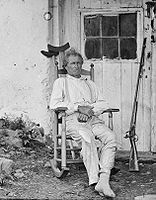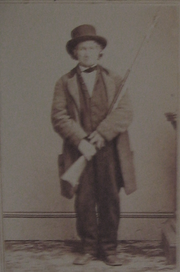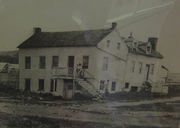
John L. Burns
Encyclopedia

War of 1812
The War of 1812 was a military conflict fought between the forces of the United States of America and those of the British Empire. The Americans declared war in 1812 for several reasons, including trade restrictions because of Britain's ongoing war with France, impressment of American merchant...
, became a 70-year-old civilian combatant with the Union Army
Union Army
The Union Army was the land force that fought for the Union during the American Civil War. It was also known as the Federal Army, the U.S. Army, the Northern Army and the National Army...
at the Battle of Gettysburg
Battle of Gettysburg
The Battle of Gettysburg , was fought July 1–3, 1863, in and around the town of Gettysburg, Pennsylvania. The battle with the largest number of casualties in the American Civil War, it is often described as the war's turning point. Union Maj. Gen. George Gordon Meade's Army of the Potomac...
during the American Civil War
American Civil War
The American Civil War was a civil war fought in the United States of America. In response to the election of Abraham Lincoln as President of the United States, 11 southern slave states declared their secession from the United States and formed the Confederate States of America ; the other 25...
. He was wounded, but survived to become a national celebrity.
Life

Burlington, New Jersey
Burlington is a city in Burlington County, New Jersey, United States and a suburb of Philadelphia. As of the 2010 United States Census, the city population was 9,920....
, of Scottish ancestry; his father claimed a relationship with poet Robert Burns
Robert Burns
Robert Burns was a Scottish poet and a lyricist. He is widely regarded as the national poet of Scotland, and is celebrated worldwide...
. He served as an enlisted man in the War of 1812, fighting in numerous battles, including Lundy's Lane
Battle of Lundy's Lane
The Battle of Lundy's Lane was a battle of the Anglo-American War of 1812, which took place on 25 July 1814, in present-day Niagara Falls, Ontario...
, and volunteered for both the Mexican-American War and the Civil War. He was rejected for combat duty in the latter war due to his advanced age, but he served as a teamster in support of the Union Army. He was sent home against his will to Gettysburg, Pennsylvania
Gettysburg, Pennsylvania
Gettysburg is a borough that is the county seat, part of the Gettysburg Battlefield, and the eponym for the 1863 Battle of Gettysburg. The town hosts visitors to the Gettysburg National Military Park and has 3 institutions of higher learning: Lutheran Theological Seminary, Gettysburg College, and...
, where he was named constable
Constable
A constable is a person holding a particular office, most commonly in law enforcement. The office of constable can vary significantly in different jurisdictions.-Etymology:...
. During Confederate
Confederate States Army
The Confederate States Army was the army of the Confederate States of America while the Confederacy existed during the American Civil War. On February 8, 1861, delegates from the seven Deep South states which had already declared their secession from the United States of America adopted the...
Maj. Gen. Jubal A. Early's brief occupation of Gettysburg on June 26, 1863, Burns was jailed for his adamant assertion of civil authority in resisting Early. As the Confederates departed, Burns was released from jail and arrested some of the Confederate stragglers , continuing his opposition to the invading army until he was relieved by Federal cavalry under Brig. Gen.
Brigadier general (United States)
A brigadier general in the United States Army, Air Force, and Marine Corps, is a one-star general officer, with the pay grade of O-7. Brigadier general ranks above a colonel and below major general. Brigadier general is equivalent to the rank of rear admiral in the other uniformed...
John Buford
John Buford
John Buford, Jr. was a Union cavalry officer during the American Civil War, with a prominent role at the start of the Battle of Gettysburg.-Early years:...
.
On the first day of the Battle of Gettysburg
Battle of Gettysburg
The Battle of Gettysburg , was fought July 1–3, 1863, in and around the town of Gettysburg, Pennsylvania. The battle with the largest number of casualties in the American Civil War, it is often described as the war's turning point. Union Maj. Gen. George Gordon Meade's Army of the Potomac...
, July 1, 1863, Burns took up his flintlock musket and powder horn and walked out to the scene of the fighting that morning. He encountered a wounded Union soldier and asked if he could use his more modern rifle; the soldier agreed and Burns moved on with the rifle and with cartridges in his pocket. Approaching Major Thomas Chamberlin of the 150th Pennsylvania Infantry, Burns requested that he be allowed to fall in with the regiment. Chamberlin later wrote of Burns moving with deliberate step, carrying his Enfield rifle at a trail. His somewhat peculiar dress "consisted of dark trousers and a waistcoat, a blue 'swallow tail' coat with burnished brass buttons, such as used to be affected by well-to-do gentlemen of the old school about 40 years ago, and a high black silk hat, from which most of the original gloss had long departed, of a shape to be found only in the fashion plates of the remote past." Despite his skepticism about the request, Chamberlin referred him to the regimental commander, Colonel Langhorne Wister, who sent the aged Burns into the woods next to the McPherson Farm, where he would find better shelter from the sun and enemy bullets.
In McPherson (Herbst) Woods, Burns fought with the 7th Wisconsin Infantry and then moved to join the 24th Michigan near the eastern end of the woods. He fought beside these men of the famous Iron Brigade
Iron Brigade
The Iron Brigade, also known as the Iron Brigade of the West or the Black Hat Brigade, was an infantry brigade in the Union Army of the Potomac during the American Civil War. Although it fought entirely in the Eastern Theater, it was composed of regiments from Western states...
throughout the afternoon, serving effectively as a sharpshooter, in one case shooting a charging Confederate officer from his horse. As the Union line began to give way and they fell back to the Seminary
Lutheran Theological Seminary at Gettysburg
The Lutheran Theological Seminary at Gettysburg is America's oldest Lutheran seminary and a site of 1863 Battle of Gettysburg military engagements.-History:...
, Burns received wounds in the arm, the leg, and several minor ones in the breast; the Union soldiers were forced to leave him behind on the field. Injured and exhausted, the old man was able to crawl away from his rifle and to hastily bury his ammunition. He convinced the Confederates that he was a noncombatant, wandering the battlefield seeking aid for his invalid wife, and his wounds were dressed by their surgeons. This was a narrow escape for Burns, for by the rules of war he was subject to summary execution as a non-uniformed combatant, or bushwhacker
Bushwhacker
Bushwhacking was a form of guerrilla warfare common during the American Revolutionary War, American Civil War and other conflicts in which there are large areas of contested land and few Governmental Resources to control these tracts...
. He was able to crawl that evening to the cellar of the nearest house, and was later conveyed to his own home, where he was treated by Dr. Charles Horner.

Mathew Brady
Mathew B. Brady was one of the most celebrated 19th century American photographers, best known for his portraits of celebrities and his documentation of the American Civil War...
's photographer Timothy H. O'Sullivan
Timothy H. O'Sullivan
Timothy H. O'Sullivan was a photographer widely known for his work related to the American Civil War and the Western United States.O'Sullivan was born in New York City. As a teenager, he was employed by Mathew Brady...
photographed Burns while recuperating at his home on Chambersburg Street and took the story of Burns and his participation in the battle back home to Washington. When President
President of the United States
The President of the United States of America is the head of state and head of government of the United States. The president leads the executive branch of the federal government and is the commander-in-chief of the United States Armed Forces....
Abraham Lincoln
Abraham Lincoln
Abraham Lincoln was the 16th President of the United States, serving from March 1861 until his assassination in April 1865. He successfully led his country through a great constitutional, military and moral crisis – the American Civil War – preserving the Union, while ending slavery, and...
came to Gettysburg to dedicate the Soldiers National Cemetery and deliver his Gettysburg Address
Gettysburg Address
The Gettysburg Address is a speech by U.S. President Abraham Lincoln and is one of the most well-known speeches in United States history. It was delivered by Lincoln during the American Civil War, on the afternoon of Thursday, November 19, 1863, at the dedication of the Soldiers' National Cemetery...
that fall, he requested to meet with Burns. Burns accompanied the president on a walk from the David Wills
David Wills (Gettysburg)
David Wills was the principal figure in the establishment of the National Cemetery at Gettysburg, Pennsylvania. As a result of his efforts, the Gettysburg Address was given by Abraham Lincoln. Wills was Lincoln's host while in Gettysburg, and the Gettysburg Address was completed in...
house to the Presbyterian Church on Baltimore Street on November 19, 1863. Burns's fame quickly spread and a poem about his exploits was published by Bret Harte
Bret Harte
Francis Bret Harte was an American author and poet, best remembered for his accounts of pioneering life in California.- Life and career :...
in 1864.
According to Burns's biography in Appleton's Cyclopedia
Appleton's Cyclopedia of American Biography
Appletons' Cyclopædia of American Biography is a six-volume collection of biographies of famous Americans. It was published between 1887 and 1889 by D. Appleton and Company, New York. The general editors were James Grant Wilson and John Fiske; the managing editor from 1886 to 1888 was Rossiter...
, during the last two years of his life his mind failed, and his friends were unable to prevent his wandering about the country. He was found in New York City
New York City
New York is the most populous city in the United States and the center of the New York Metropolitan Area, one of the most populous metropolitan areas in the world. New York exerts a significant impact upon global commerce, finance, media, art, fashion, research, technology, education, and...
on a cold winter's night in December 1871, in a state of destitution, and was cared for and sent home, but died of pneumonia in 1872.
In memoriam
The popularity of John Burns's participation in the battle grew in the post war years. His home on Chambersburg Street was razed after his death and veterans of the battle remarked that something should be done to commemorate his services. Reacting to a proposal by a Pennsylvania chapter of the Sons of Union VeteransSons of Union Veterans of the Civil War
Sons of Union Veterans of the Civil War is an American fraternal organization, the legal successor to the Grand Army of the Republic . Founded in late 1881, it was originally one of several competing organizations of descendants of Union veterans...
, the state enacted legislation to provide funds for a fitting monument. The Pennsylvania Board of Commissioners on Gettysburg Monuments desired that the monument be placed on the field where Burns had fought with the 150th Pennsylvania and 7th Wisconsin regiments, and a site was chosen on McPherson's Ridge next to Herbst Woods. Sculptor Albert G. Bureau chose to depict a defiant Burns with clenched fist, stubbornly carrying his flintlock musket in battle, rather than the borrowed rifled musket he actually used. Placed upon a boulder taken from the battlefield, the monument was dedicated on July 1, 1903, on the occasion of the 40th anniversary of the battle.
Burns is buried in Evergreen Cemetery
Evergreen Cemetery (Gettysburg, Pennsylvania)
Evergreen Cemetery is a privately-owned rural cemetery near Gettysburg, Pennsylvania, with 5 notable interments: John L. Burns , Steve Courson , Marianne Moore , Eddie Plank , and Oscar Shaw...
in Gettysburg, one of only two graves there with permission to fly the American flag twenty-four hours per day (the other being the grave of Ginnie Wade, the only civilian killed during the battle). His original gravestone was vandalized, but replaced by the local chapter of the Grand Army of the Republic
Grand Army of the Republic
The Grand Army of the Republic was a fraternal organization composed of veterans of the Union Army, US Navy, US Marines and US Revenue Cutter Service who served in the American Civil War. Founded in 1866 in Decatur, Illinois, it was dissolved in 1956 when its last member died...
in 1902. It bears the inscription "Patriot".
External links
- Brief biography of John Burns at Jennie Wade House
- Gettysburg Association of Licensed Battlefield Guides description of Burns
- John Burns of Gettysburg, a poem by Bret HarteBret HarteFrancis Bret Harte was an American author and poet, best remembered for his accounts of pioneering life in California.- Life and career :...

